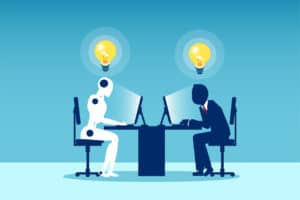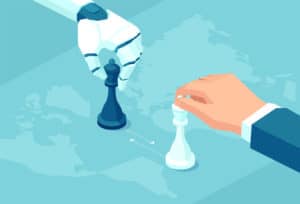 As the head of fixed income trading at a European bank in 2007, Jens Kramarczik was troubled by the early stages of the US subprime mortgage crisis.
As the head of fixed income trading at a European bank in 2007, Jens Kramarczik was troubled by the early stages of the US subprime mortgage crisis.
He shifted out of risk assets, shorted Italian government bonds and bought the yen as a flight to safety. In this case, human judgement was the key, and the shift was made “long before the rocket science told us to,” he says.
These days, Kramarczik is a consultant in trading algorithms, working from home in Frankfurt. He had a sense of déjà vu as the COVID-19 pandemic prompted market collapse. While algorithms did not cause the mess, they were “not very helpful in March,” he explains. There was the same sense of panic that he witnessed in 2007. “People think that if they use algorithms they are not emotionally involved,” he says. “But that’s not true.”
Kramarczik now uses simple algorithms to identify the best days of the month on which to buy securities, or the best hour within a day. He sees gold as a “safety net” against the massive amounts of liquidity that have been injected into the financial system. Even having reached record levels, gold can still provide “insurance for the future,” he believes.
Still, he treats algorithms as a tool rather than a guide. “If there are moves that are not in your database, it becomes difficult,” he says. “Sometimes the correlation disappears.”
Flash Crash
The benefits of algorithms are obvious: much more efficient investment research and faster trading execution. Algorithms are also used to reduce the market impact of big trades as they make it easier to subdivide orders, so the size of the trades will not be apparent.
The behavioural biases of traders, at least in theory, are eliminated. This doesn’t come for free: market exchanges still experience software glitches, the effect of which can be magnified and spread by algorithms.
“There is no argument” that algorithmic trading adds more liquidity to the markets, says Ashu Swami, chief technology officer at Apifiny, a global trading and financial value transfer network in New York. But, given their high volumes and automatic nature, “if they go wrong and are not contained, they can cause sharp swings in the market”. Swami previously led the high frequency market-making business at Morgan Stanley.
Algorithms are often used to instantly exploit even minor price discrepancies in the same security trading in different markets. The International Organisation of Securities Commissions (IOSCO) Technical Committee in 2011 found that algorithms can quickly transmit shocks rapidly from one market to the next, so amplifying systemic risk.
A classic example is the ‘Flash Crash’ of 6 May 2010 when more than a trillion dollars was temporarily wiped off US equity prices. Computer programs exacerbated the damage by selling large volumes of stocks in response to the volatility. Greater use of market-wide circuit breakers was a result.
COVID-19
Rather than a financial or market-led crisis, COVID-19 is a crisis of health and the economy. Some argue that algorithmic trading allowed a prompt, if partial, recovery from the COVID-19 lows seen early this year. The danger now, Swami says, is one of contagion.
When an algorithm goes wrong, “the other algos either see it as an anomaly and pull their quotes, or they make unreasonable trading decisions based on the outlier prices”. Swami is confident that the problem will tend to be reduced over time: “More people using algos will lead to their democratisation and lessen deleterious contagion.”
The volatility seen in March was a function of the pandemic rather than being caused by algorithms, says Ray Ross, co-head of electronic trading at BMO Capital Markets in New York. BMO, he claims, performed well for its clients while using algorithms.
BMO uses algorithms to manage execution and market impact, rather than to generate trading ideas. Given the fact that they can be used for any kind of strategy, Ross sees little danger that they will all give off the same signal. Neither does Ross see algorithms as being responsible for increased numbers of failed trades in March. He sees settlement and clearing as the more likely candidates: “my guess is that it’s at that end.”
BMO Capital Markets has been functioning pretty much as usual with people working from home, Ross says. They will keep doing so for the foreseeable future and he expects the change in working culture to outlast the pandemic. Working from home is “a real improvement” due to technological improvements in the years before the pandemic.
Still, the ability to meet face-to- face with clients is missing, he says. That is what will drive decision-making about getting people back into the office. “There’s no way to make up for personal contact.” The most likely result is a “hybrid comeback”.
High-frequency trading
For Dejan Ilijevski, president at Sabela Capital Markets in Chicago, the pandemic has expanded the opportunities to use algorithms for high-frequency trading (HFT).
“When markets are slow and flat, there are no triggers, no edges, no opportunities for profits,” he explains. “Uncertainty is the main source for volatility, and the con- text around COVID-19 is all about uncertainty.”
Since market efficiency depends on price discovery, an increase in trading volumes and market participation leads to fairer asset prices, Ilijevski argues. HFT has also led to lower transactional costs for investors, he adds.
BMO’s Ross takes a more nuanced view. He does not expect there to be a decline in high-frequency strategies. Under normal conditions, he counters, high-frequency traders reduce volatility, but at times of stress, they can serve to create a “phantom” illusion of liquidity. The order books look full, but no-one is really willing to step in and take the risk. “People think there’s more liquidity in the market than there really is.”
 Liquidity auctions
Liquidity auctions
Ross also points to US volatility auctions as showing a weak point in algorithms. The US had a level 1 cross-market trading halt on 9 March for the first time in 20 years, and this was followed by three more such halts.
Market-wide circuit breakers force a pause to let markets reset from extraordinary spikes in volatility. The halts led to volatility auctions designed to allow price discovery.
“That’s not really what we saw,” Ross says.
Since auctions are a key form of price discovery, lack of participation is likely to have an impact on the market once the auction is over, Ross contends. He points to post-volatility auction trading volumes and price moves which were significantly higher compared with the first minute of trading after a typical opening auction: stabilisation has still not been achieved. Some brokers were completely unable to support participation in the auctions.
The most likely explanation, he believes, is that algorithms were not coded to handle such events. The algorithm “only really knows what it has seen before,” and so chose to sit the auctions out, leaving the markets to fend for themselves.
Managing an automated options market making model for about 20 years taught Steve Sosnick that successful algorithms “need to be tweaked constantly”. A shock that is beyond the normal scope of a model “doesn’t invalidate the algorithms inside it, but it does force a larger re-evaluation of its underlying premises,” says Sosnick, now chief strategist at Interactive Brokers in Connecticut.
“Profitability should never take a back seat to risk management,” he says. “We learned the hard way who focused on reward without sufficient focus on risk.”
There’s no way that algorithms and HFT are going to go away, Sosnick adds. The key is managing control. Practitioners must “maintain risk controls that work even in extraordinary circumstances”.
Artificial intelligence
Algorithms can be divided between those that simply follow the rules laid down in the programme, and those that are linked to machine learning and artificial intelligence (AI). In the latter case, the aim is for these “self-learning” algorithms to be updated automatically in a changing situation, without human intervention.
The danger is that the speed at which these algorithms learn will outpace human capacity to manage and regulate them. According to a report in June from the International Organisation of Securities Commissions (IOSC), AI and machine learning (ML) can “create or amplify” risks for financial markets.
Regulators should consider requiring firms to have designated senior management responsible for monitoring and controlling AI and ML, the report says. Regulators should also require firms to continuously test algorithms to validate the results of the techniques used, the IOSC said. Further, compliance and risk
management functions need to be able to understand and challenge the algorithms that are produced, and conduct due diligence on third-party providers.
Ross says the danger of market manipulation is “a regulatory concern”. “The machine does not know the regulations. It could certainly come up with something that does not meet market norms.”
Still, he believes the same kind of dangers exist with human traders as with algorithms and “it’s easier to shut down the machine than the human”. Of course, rogue human traders are easier to prosecute once you find them. But who gets prosecuted when the algorithms go wrong?